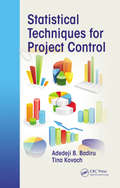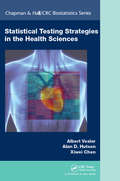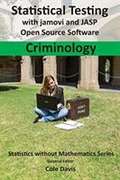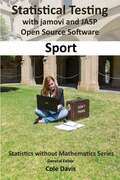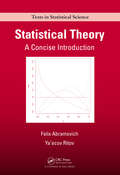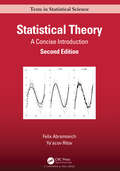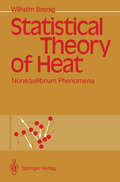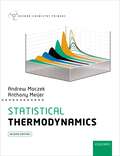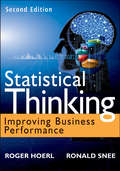- Table View
- List View
Statistical Techniques for Neuroscientists (Foundations and Innovations in Neurobiology)
by Young K. Truong Mechelle M. LewisStatistical Techniques for Neuroscientists introduces new and useful methods for data analysis involving simultaneous recording of neuron or large cluster (brain region) neuron activity. The statistical estimation and tests of hypotheses are based on the likelihood principle derived from stationary point processes and time series. Algorithms and software development are given in each chapter to reproduce the computer simulated results described therein. The book examines current statistical methods for solving emerging problems in neuroscience. These methods have been applied to data involving multichannel neural spike train, spike sorting, blind source separation, functional and effective neural connectivity, spatiotemporal modeling, and multimodal neuroimaging techniques. The author provides an overview of various methods being applied to specific research areas of neuroscience, emphasizing statistical principles and their software. The book includes examples and experimental data so that readers can understand the principles and master the methods. The first part of the book deals with the traditional multivariate time series analysis applied to the context of multichannel spike trains and fMRI using respectively the probability structures or likelihood associated with time-to-fire and discrete Fourier transforms (DFT) of point processes. The second part introduces a relatively new form of statistical spatiotemporal modeling for fMRI and EEG data analysis. In addition to neural scientists and statisticians, anyone wishing to employ intense computing methods to extract important features and information directly from data rather than relying heavily on models built on leading cases such as linear regression or Gaussian processes will find this book extremely helpful.
Statistical Techniques for Project Control
by Adedeji B. Badiru Tina AgustiadyWinner of the IIE Book of the Month for June 2012A project can be simple or complex. In each case, proven project management processes must be followed. In all cases of project management implementation, control must be exercised in order to assure that project objectives are achieved. Statistical Techniques for Project Control seamlessly integrate
Statistical Testing Strategies in the Health Sciences (Chapman & Hall/CRC Biostatistics Series)
by Albert Vexler Alan D. Hutson Xiwei ChenStatistical Testing Strategies in the Health Sciences provides a compendium of statistical approaches for decision making, ranging from graphical methods and classical procedures through computationally intensive bootstrap strategies to advanced empirical likelihood techniques. It bridges the gap between theoretical statistical methods and practical procedures applied to the planning and analysis of health-related experiments. The book is organized primarily based on the type of questions to be answered by inference procedures or according to the general type of mathematical derivation. It establishes the theoretical framework for each method, with a substantial amount of chapter notes included for additional reference. It then focuses on the practical application for each concept, providing real-world examples that can be easily implemented using corresponding statistical software code in R and SAS. The book also explains the basic elements and methods for constructing correct and powerful statistical decision-making processes to be adapted for complex statistical applications. With techniques spanning robust statistical methods to more computationally intensive approaches, this book shows how to apply correct and efficient testing mechanisms to various problems encountered in medical and epidemiological studies, including clinical trials. Theoretical statisticians, medical researchers, and other practitioners in epidemiology and clinical research will appreciate the book’s novel theoretical and applied results. The book is also suitable for graduate students in biostatistics, epidemiology, health-related sciences, and areas pertaining to formal decision-making mechanisms.
Statistical Testing Strategies in the Health Sciences (Chapman & Hall/CRC Biostatistics Series)
by Albert Vexler Alan D. Hutson Xiwei ChenStatistical Testing Strategies in the Health Sciences provides a compendium of statistical approaches for decision making, ranging from graphical methods and classical procedures through computationally intensive bootstrap strategies to advanced empirical likelihood techniques. It bridges the gap between theoretical statistical methods and practical procedures applied to the planning and analysis of health-related experiments. The book is organized primarily based on the type of questions to be answered by inference procedures or according to the general type of mathematical derivation. It establishes the theoretical framework for each method, with a substantial amount of chapter notes included for additional reference. It then focuses on the practical application for each concept, providing real-world examples that can be easily implemented using corresponding statistical software code in R and SAS. The book also explains the basic elements and methods for constructing correct and powerful statistical decision-making processes to be adapted for complex statistical applications. With techniques spanning robust statistical methods to more computationally intensive approaches, this book shows how to apply correct and efficient testing mechanisms to various problems encountered in medical and epidemiological studies, including clinical trials. Theoretical statisticians, medical researchers, and other practitioners in epidemiology and clinical research will appreciate the book’s novel theoretical and applied results. The book is also suitable for graduate students in biostatistics, epidemiology, health-related sciences, and areas pertaining to formal decision-making mechanisms.
Statistical Testing With Jamovi And Jasp Open Source Software Criminology: (pdf) (Statistics without Mathematics)
by Cole DavisThis is a book on statistical testing, for beginners and intermediate students, without formulae, with worked examples from criminology.
Statistical testing with jamovi and JASP open source software Education (Statistics without Mathematics): (pdf)
by Cole DavisWorked examples from education Clearly written, without mathematical formulae Well-structured, for beginners and intermediate readers Comprehensive chapter on categorical analysis - not just 'Chi squared' Effect sizes and confidence intervals Clear explanation of factor analysis Covers MANOVA, logistic regression and survival analysis Introduces Bayesian statistics Reproduces a well-received short chapter on making presentations Data sets and case studies on the website
Statistical testing with jamovi and JASP open source software Health: (pdf)
by Cole DavisWorked examples from nursing, medicine and other health disciplines Clearly written, without mathematical formulae Well-structured, for beginners and intermediate readers Comprehensive chapter on categorical analysis - not just 'Chi squared' Effect sizes and confidence intervals Clear explanation of factor analysis Covers MANOVA, logistic regression and survival analysis Introduces Bayesian statistics Reproduces a well-received short chapter on making presentations Data sets and case studies on the website
Statistical testing with jamovi and JASP open source software Sport (Statistics without Mathematics): (pdf)
by Cole DavisWorked examples from sport Clearly written, without mathematical formulae Well-structured, for beginners and intermediate readers Comprehensive chapter on categorical analysis - not just 'Chi squared' Effect sizes and confidence intervals Clear explanation of factor analysis Covers MANOVA, logistic regression and survival analysis Introduces Bayesian statistics Reproduces a well-received short chapter on making presentations Data sets and case studies on the website
Statistical Tests for Mixed Linear Models (Wiley Series in Probability and Statistics #906)
by André I. Khuri Thomas Mathew Bimal K. SinhaAn advanced discussion of linear models with mixed or random effects. In recent years a breakthrough has occurred in our ability to draw inferences from exact and optimum tests of variance component models, generating much research activity that relies on linear models with mixed and random effects. This volume covers the most important research of the past decade as well as the latest developments in hypothesis testing. It compiles all currently available results in the area of exact and optimum tests for variance component models and offers the only comprehensive treatment for these models at an advanced level. Statistical Tests for Mixed Linear Models: Combines analysis and testing in one self-contained volume. Describes analysis of variance (ANOVA) procedures in balanced and unbalanced data situations. Examines methods for determining the effect of imbalance on data analysis. Explains exact and optimum tests and methods for their derivation. Summarizes test procedures for multivariate mixed and random models. Enables novice readers to skip the derivations and discussions on optimum tests. Offers plentiful examples and exercises, many of which are numerical in flavor. Provides solutions to selected exercises. Statistical Tests for Mixed Linear Models is an accessible reference for researchers in analysis of variance, experimental design, variance component analysis, and linear mixed models. It is also an important text for graduate students interested in mixed models.
Statistical Theory: A Concise Introduction (Chapman And Hall/crc Texts In Statistical Science Ser.)
by Felix AbramovichDesigned for a one-semester advanced undergraduate or graduate course, Statistical Theory: A Concise Introduction clearly explains the underlying ideas and principles of major statistical concepts, including parameter estimation, confidence intervals, hypothesis testing, asymptotic analysis, Bayesian inference, and elements of decision theory. It i
Statistical Theory: A Concise Introduction (Chapman & Hall/CRC Texts in Statistical Science)
by Felix Abramovich Ya'acov RitovDesigned for a one-semester advanced undergraduate or graduate statistical theory course, Statistical Theory: A Concise Introduction, Second Edition clearly explains the underlying ideas, mathematics, and principles of major statistical concepts, including parameter estimation, confidence intervals, hypothesis testing, asymptotic analysis, Bayesian inference, linear models, nonparametric statistics, and elements of decision theory. It introduces these topics on a clear intuitive level using illustrative examples in addition to the formal definitions, theorems, and proofs. Based on the authors’ lecture notes, the book is self-contained, which maintains a proper balance between the clarity and rigor of exposition. In a few cases, the authors present a "sketched" version of a proof, explaining its main ideas rather than giving detailed technical mathematical and probabilistic arguments. Features: Second edition has been updated with a new chapter on Nonparametric Estimation; a significant update to the chapter on Statistical Decision Theory; and other updates throughout No requirement for heavy calculus, and simple questions throughout the text help students check their understanding of the material Each chapter also includes a set of exercises that range in level of difficulty Self-contained, and can be used by the students to understand the theory Chapters and sections marked by asterisks contain more advanced topics and may be omitted Special chapters on linear models and nonparametric statistics show how the main theoretical concepts can be applied to well-known and frequently used statistical tools The primary audience for the book is students who want to understand the theoretical basis of mathematical statistics—either advanced undergraduate or graduate students. It will also be an excellent reference for researchers from statistics and other quantitative disciplines.
Statistical Theory: A Concise Introduction (Chapman & Hall/CRC Texts in Statistical Science)
by Felix Abramovich Ya'acov RitovDesigned for a one-semester advanced undergraduate or graduate statistical theory course, Statistical Theory: A Concise Introduction, Second Edition clearly explains the underlying ideas, mathematics, and principles of major statistical concepts, including parameter estimation, confidence intervals, hypothesis testing, asymptotic analysis, Bayesian inference, linear models, nonparametric statistics, and elements of decision theory. It introduces these topics on a clear intuitive level using illustrative examples in addition to the formal definitions, theorems, and proofs. Based on the authors’ lecture notes, the book is self-contained, which maintains a proper balance between the clarity and rigor of exposition. In a few cases, the authors present a "sketched" version of a proof, explaining its main ideas rather than giving detailed technical mathematical and probabilistic arguments. Features: Second edition has been updated with a new chapter on Nonparametric Estimation; a significant update to the chapter on Statistical Decision Theory; and other updates throughout No requirement for heavy calculus, and simple questions throughout the text help students check their understanding of the material Each chapter also includes a set of exercises that range in level of difficulty Self-contained, and can be used by the students to understand the theory Chapters and sections marked by asterisks contain more advanced topics and may be omitted Special chapters on linear models and nonparametric statistics show how the main theoretical concepts can be applied to well-known and frequently used statistical tools The primary audience for the book is students who want to understand the theoretical basis of mathematical statistics—either advanced undergraduate or graduate students. It will also be an excellent reference for researchers from statistics and other quantitative disciplines.
Statistical Theory and Applications: Papers in Honor of Herbert A. David
by H. N. Nagaraja Pranab K. Sen Donald F. MorrisonProfessor Herbert A. David of Iowa State University will be turning 70 on December 19, 1995. He is reaching this milestone in life with a very distinguished career as a statistician, educator and administrator. We are bringing out this volume in his honor to celebrate this occasion and to recognize his contributions to order statistics, biostatistics and design of experiments, among others; and to the statistical profession in general. With great admiration, respect and pleasure we dedicate this festschrift to Professor Herbert A. David, also known as Herb and H.A. among his friends, colleagues and students. When we began this project in Autumn 1993 and contacted potential contributors from the above group, the enthu siasm was phenomenal. The culmination of this collective endeavor is this volume that is being dedicated to him to celebrate his upcoming birthday. Several individuals have contributed in various capacities to the success ful completion of this project. We sincerely thank the authors of the papers appearing here. Without their dedicated work, we would just have this pref ace! Many of them have served as (anonymous) referees as well. In addition, we are thankful to the following colleagues for their time and advice: John Bunge (Cornell), Z. Govindarajulu (Kentucky), John Klein (Medical U.
Statistical Theory and Computational Aspects of Smoothing: Proceedings of the COMPSTAT ’94 Satellite Meeting held in Semmering, Austria, 27–28 August 1994 (Contributions to Statistics)
by Wolfgang Härdle Michael SchimekOne of the main applications of statistical smoothing techniques is nonparametric regression. For the last 15 years there has been a strong theoretical interest in the development of such techniques. Related algorithmic concepts have been a main concern in computational statistics. Smoothing techniques in regression as well as other statistical methods are increasingly applied in biosciences and economics. But they are also relevant for medical and psychological research. Introduced are new developments in scatterplot smoothing and applications in statistical modelling. The treatment of the topics is on an intermediate level avoiding too much technicalities. Computational and applied aspects are considered throughout. Of particular interest to readers is the discussion of recent local fitting techniques.
Statistical Theory and Inference
by David J. OliveThis text is for a one semester graduate course in statistical theory and covers minimal and complete sufficient statistics, maximum likelihood estimators, method of moments, bias and mean square error, uniform minimum variance estimators and the Cramer-Rao lower bound, an introduction to large sample theory, likelihood ratio tests and uniformly most powerful tests and the Neyman Pearson Lemma. A major goal of this text is to make these topics much more accessible to students by using the theory of exponential families.Exponential families, indicator functions and the support of the distribution are used throughout the text to simplify the theory. More than 50 ``brand name" distributions are used to illustrate the theory with many examples of exponential families, maximum likelihood estimators and uniformly minimum variance unbiased estimators. There are many homework problems with over 30 pages of solutions.
Statistical Theory of Heat: Nonequilibrium Phenomena
by Wilhelm BrenigThis text on the statistical theory of nonequilibrium phenomena grew out of lecture notes for courses on advanced statistical mechanics that were held more or less regularly at the Physics Department of the Technical University in Munich. My aim in these lectures was to incorporate various developments of many-body theory made during the last 20-30 years, in particular the correlation function approach, not just as an "extra" alongside the more "classical" results; I tried to use this approach as a unifying concept for the presentation of older as well as more recent results. I think that after so many excellent review articles and advanced treatments, correlation functions and memory kernels are as much a matter of course in nonequilibrium statistical physics as partition functions are in equilibrium theory, and should be used as such in regular courses and textbooks. The relations between correlation functions and earlier vehicles for the formulation of nonequilibrium theory such as kinetic equations, master equations, Onsager's theory, etc. , are discussed in detail in this volume. Since today there is growing interest in nonlinear phenomena I have included several chapters on related problems. There is some nonlinear response theory, some results on phenomenological nonlinear equations and some microscopic applications of the nonlinear response formalism. The main focus, however, is on the linear regime.
Statistical Theory of Heat (Graduate Texts in Physics)
by Florian ScheckScheck’s textbook starts with a concise introduction to classical thermodynamics, including geometrical aspects. Then a short introduction to probabilities and statistics lays the basis for the statistical interpretation of thermodynamics. Phase transitions, discrete models and the stability of matter are explained in great detail.Thermodynamics has a special role in theoretical physics. Due to the general approach of thermodynamics the field has as a bridging function between several areas like the theory of condensed matter, elementary particle physics, astrophysics and cosmology. The classical thermodynamics describes predominantly averaged properties of matter, reaching from few particle systems and state of matter to stellar objects. Statistical Thermodynamics covers the same fields, but explores them in greater depth and unifies classical statistical mechanics with quantum theory of multiple particle systems.The content is presented as two tracks: the fast track for master students, providing the essentials, and the intensive track for all wanting to get in depth knowledge of the field. Clearly labelled material and sections guide students through the preferred level of treatment. Numerous problems and worked examples will provide successful access to Statistical Physics and Thermodynamics.
Statistical Theory of Open Systems: Volume 1: A Unified Approach to Kinetic Description of Processes in Active Systems (Fundamental Theories of Physics #67)
by Yu.L. KlimontovichLet us begin by quoting from the Preface to the author's Statistical Physics (Moscow, Nauka 1982; also published in English by Harwood in 1986): '''My God! Yet another book on statistical physics! There's no room on my bookshelves left!' Such emotionsare quite understandable. Beforejumping to conclusions, however, it would be worthwhile to read the Introduction and look through the table of contents. Then the reader will find that this book is totally different from the existing courses, fundamental and concise. ... We do not use the conventional division into statistical theories ofequilibrium and nonequilibrium states. Rather than that, the theory ofnonequilibrium state is the basis and the backbone oftheentirecourse. ... This approach allows us to develop a unified method for statistical description ofa very broadclassofsystems. ... The author certainly does not wish to exaggerate the advantages of the book, considering it asjustthe first attemptto create a textbookofa new kind." The next step in this direction was the author's Turbulent Motion and the Structure of Chaos (Moscow, Nauka 1990; Kluwer Academic Publishers 1991). This book is subtitled A New Approach to the Statistical Theory of Open Systems. Naturally, the "new approach" is not meant to defy the consistent and efficient methods of the conventional statistical theory; itshould be regarded as auseful reinforcementofsuch methods.
The Statistical Theory of Shape (Springer Series in Statistics)
by Christopher G. SmallIn general terms, the shape of an object, data set, or image can be de fined as the total of all information that is invariant under translations, rotations, and isotropic rescalings. Thus two objects can be said to have the same shape if they are similar in the sense of Euclidean geometry. For example, all equilateral triangles have the same shape, and so do all cubes. In applications, bodies rarely have exactly the same shape within measure ment error. In such cases the variation in shape can often be the subject of statistical analysis. The last decade has seen a considerable growth in interest in the statis tical theory of shape. This has been the result of a synthesis of a number of different areas and a recognition that there is considerable common ground among these areas in their study of shape variation. Despite this synthesis of disciplines, there are several different schools of statistical shape analysis. One of these, the Kendall school of shape analysis, uses a variety of mathe matical tools from differential geometry and probability, and is the subject of this book. The book does not assume a particularly strong background by the reader in these subjects, and so a brief introduction is provided to each of these topics. Anyone who is unfamiliar with this material is advised to consult a more complete reference. As the literature on these subjects is vast, the introductory sections can be used as a brief guide to the literature.
Statistical Thermodynamics (Oxford Chemistry Primers)
by Andrew Maczek Anthony MeijerThe renowned Oxford Chemistry Primers series, which provides focused introductions to a range of important topics in chemistry, has been refreshed and updated to suit the needs of today's students, lecturers, and postgraduate researchers. The rigorous, yet accessible, treatment of each subject area is ideal for those wanting a primer in a given topic to prepare them for more advanced study or research. The learning features provided, including end of book problems and online multiple-choice questions, encourage active learning and promote understanding. Furthermore, frequent diagrams and margin notes help to enhance a student's understanding of these essential areas of chemistry. Statistical Thermodynamics gives a concise and accessible account of this fundamental topic by emphasizing the underlying physical chemistry, and using this to introduce the mathematics in an approachable way. The material is presented in short, self-contained sections making it flexible to teach and learn from, and concludes with the application of the theory to real systems. Online Resource Centre: The Online Resource Centre to accompany Statistical Thermodynamics features: For registered adopters of the text: · Figures from the book available to download For students: · Worked solutions to the questions and problems at the end of the book. · Multiple-choice questions for self-directed learning
Statistical Thermodynamics (Oxford Chemistry Primers)
by Andrew Maczek Anthony MeijerThe renowned Oxford Chemistry Primers series, which provides focused introductions to a range of important topics in chemistry, has been refreshed and updated to suit the needs of today's students, lecturers, and postgraduate researchers. The rigorous, yet accessible, treatment of each subject area is ideal for those wanting a primer in a given topic to prepare them for more advanced study or research. The learning features provided, including end of book problems and online multiple-choice questions, encourage active learning and promote understanding. Furthermore, frequent diagrams and margin notes help to enhance a student's understanding of these essential areas of chemistry. Statistical Thermodynamics gives a concise and accessible account of this fundamental topic by emphasizing the underlying physical chemistry, and using this to introduce the mathematics in an approachable way. The material is presented in short, self-contained sections making it flexible to teach and learn from, and concludes with the application of the theory to real systems. Online Resource Centre: The Online Resource Centre to accompany Statistical Thermodynamics features: For registered adopters of the text: · Figures from the book available to download For students: · Worked solutions to the questions and problems at the end of the book. · Multiple-choice questions for self-directed learning
Statistical Thermodynamics and Differential Geometry of Microstructured Materials (The IMA Volumes in Mathematics and its Applications #51)
by H. Ted Davis Johannes C. C. NitscheSubstances possessing heterogeneous microstructure on the nanometer and micron scales are scientifically fascinating and technologically useful. Examples of such substances include liquid crystals, microemulsions, biological matter, polymer mixtures and composites, vycor glasses, and zeolites. In this volume, an interdisciplinary group of researchers report their developments in this field. Topics include statistical mechanical free energy theories which predict the appearance of various microstructures, the topological and geometrical methods needed for a mathematical description of the subparts and dividing surfaces of heterogeneous materials, and modern computer-aided mathematical models and graphics for effective exposition of the salient features of microstructured materials.
Statistical Thermodynamics for Pure and Applied Sciences: Statistical Thermodynamics
by Frederick Richard McCourtThis textbook concerns thermal properties of bulk matter and is aimed at advanced undergraduate or first-year graduate students in a range of programs in science or engineering. It provides an intermediate level presentation of statistical thermodynamics for students in the physical sciences (chemistry, nanosciences, physics) or related areas of applied science/engineering (chemical engineering, materials science, nanotechnology engineering), as they are areas in which statistical mechanical concepts play important roles. The book enables students to utilize microscopic concepts to achieve a better understanding of macroscopic phenomena and to be able to apply these concepts to the types of sub-macroscopic systems encountered in areas of nanoscience and nanotechnology.
Statistical Thinking: Improving Business Performance (Wiley and SAS Business Series #58)
by Roger Hoerl Ron D. SneeHow statistical thinking and methodology can help you make crucial business decisions Straightforward and insightful, Statistical Thinking: Improving Business Performance, Second Edition, prepares you for business leadership by developing your capacity to apply statistical thinking to improve business processes. Unique and compelling, this book shows you how to derive actionable conclusions from data analysis, solve real problems, and improve real processes. Here, you'll discover how to implement statistical thinking and methodology in your work to improve business performance. Explores why statistical thinking is necessary and helpful Provides case studies that illustrate how to integrate several statistical tools into the decision-making process Facilitates and encourages an experiential learning environment to enable you to apply material to actual problems With an in-depth discussion of JMP® software, the new edition of this important book focuses on skills to improve business processes, including collecting data appropriate for a specified purpose, recognizing limitations in existing data, and understanding the limitations of statistical analyses.

